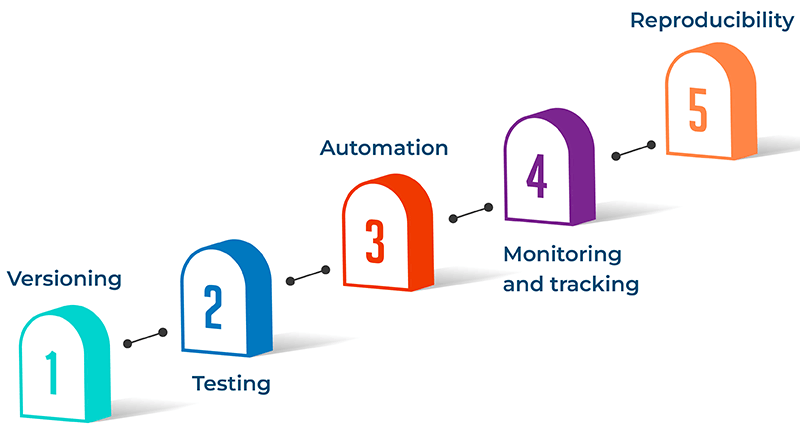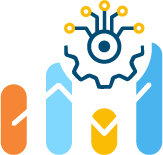
MLOps Lifecycle: Key components for sustaining Machine Learning models
In our earlier posts, we described MLOps as a set of methods and procedures intended to effectively and methodically develop, construct, and implement machine learning models. Creating and sustaining a process over time is a critical MLOps stage. This process describes the actions required to develop, implement, and manage machine learning models. It involves understanding the business problem in a structured manner, performing data engineering for preparation and preprocessing, executing machine learning model engineering from design to evaluation, and managing code engineering to serve the model.
All components of the MLOps workflow are interconnected and operate cyclically, which means revisiting earlier steps may be necessary at any stage. This interdependence defines the MLOps lifecycle, essential for ensuring that the machine learning model remains effective and continues to address the business problem identified at the outset. Thus, maintaining the MLOps lifecycle by adhering to established MLOps principles is vital.
MLOps principles
MLOps principles encompass concepts aimed at sustaining the MLOps lifecycle while minimizing the time and cost of developing and deploying machine learning models, thereby avoiding technical debt. To effectively maintain the lifecycle, these principles must be applied across various workflow stages, including data management, machine learning models (ML models), and code management. Key principles include versioning, testing, automation, monitoring and tracking, and reproducibility. Successfully implementing these principles requires appropriate tools and adherence to best practices, such as proper project structuring.
In this article, we prioritize these principles based on their significance and the sequence in which they should be applied. However, it is important to note that all these principles are crucial for mature machine learning projects; they are interdependent and support one another.
1. Versioning
Versioning is a fundamental principle in MLOps that focuses on various application components, including:
Data: Versioning encompasses datasets, features, metadata, and processing pipelines. You can manage this process using version control systems (VCS) like Git and DVC (Data Version Control), which enable effective tracking and versioning of large data files.
ML Models: Versioning includes tracking model architecture, weights, training pipelines, hyperparameters, and results. While Git is commonly used for this purpose, tools such as MLflow offer additional functionalities, including the ability to version other metadata.
Code: Managing the source code and its customizations is known as code versioning. To avoid compatibility problems, keeping library versions consistent with each code version is best.
Overall, versioning facilitates:
Reproducibility ensures the reproducibility of various workflow steps.
Flexibility enables developers and data scientists to revert to previous versions when necessary, compare performance between versions, and reproduce results.
Change tracking allows for monitoring changes made to different MLOps components.
By effectively implementing versioning, organizations can ensure that changes to machine learning models, code, and data are systematically tracked and managed.
2. Testing
Testing is a vital aspect of MLOps. It is crucial for minimizing errors and bugs while facilitating the rapid detection and resolution of issues. It ensures that machine learning models operate as intended and fulfill the requirements of the business problem.
Data testing: The accuracy and dependability of the models depend on this procedure, which confirms the integrity and quality of the data used in machine learning. Crucial elements include:
Dataset validation: Identifying missing values and inconsistencies through statistical analysis and visualization techniques.
Data processing pipeline validation: Conducting unit tests on various data processing functions, particularly those related to feature creation.
ML Model testing ensures that the model makes accurate predictions on new data and assesses its generalization capabilities. This process involves:
Evaluating model specifications and their integration within the training pipeline.
- Validating the model’s relevance and correctness.
- Testing non-functional requirements, such as security, fairness, and interpretability, to ensure the model’s overall effectiveness and ethical considerations.
Code testing focuses on verifying the correctness and quality of the entire MLOps project code, ensuring it is free from defects and aligns with project requirements. Code testing includes:
Unit testing individual modules and functions.
- Integration testing for the complete end-to-end pipeline.
- System testing and acceptance testing using real-world data.
In conclusion, testing is crucial to MLOps in order to preserve the integrity and effectiveness of the pipeline as a whole. It also str lengthens other MLOps principles by:
- Improving monitoring by identifying potential issues early.
- Supporting reproducibility by ensuring models can consistently perform over time.
- Confirming that code changes made during versioning work correctly.
- Enhancing automation by integrating testing into the automation pipeline.
3. Automation
Automation is a fundamental principle of MLOps that focuses on streamlining various pipeline processes, including building, testing, deploying, and managing machine learning models. The extent of automation indicates the system’s reliance on manual intervention; a higher degree of automation signifies a more mature process.
Data engineering automation: While data engineering often requires manual tasks—such as data gathering, preparation, and validation—specific steps can be automated. For example, automating data transformation and feature manipulation enhances accuracy and minimizes manual errors.
ML Model automation: This aspect aims to automate the entire workflow from model development to deployment and management. Key elements include:
- Automating feature engineering, model training, hyperparameter selection and tuning, model validation, and deployment.
- This reduces the time and resources needed for model development while improving quality and consistency, particularly when adapting to new data, model changes, or monitoring requirements.
In summary, automation facilitates the efficient and reliable execution of repetitive tasks while standardizing processes. It is connected with other MLOps principles by:
- Supporting versioning through automated management and tracking code, data, and model versions.
- Enhancing testing by automating the execution of unit, integration, and performance tests.
- Improving monitoring through automated collection, analysis, and visualization of key metrics and performance indicators.
- Aiding reproducibility by automating the execution of code, workflows, and pipelines.
Learn the key differences between Experiment Tracking, MLOps, and Experiment Management to streamline your ML/AI projects effectively → https://optscale.ai/ml-experiment-tracking-vs-mlops-vs-experiment-management/
4. Monitoring and tracking
Once the model is deployed, monitoring the MLOps project to ensure the performance, stability, and reliability of the machine learning model in production is crucial. If the monitor identifies an anomaly, reporting the changes and alerting the relevant developers is essential. Effective monitoring of the various MLOps steps involves frequently re-running and comparing processes.
Data monitoring involves continuously observing and analyzing the input data used in machine learning models to maintain its quality, consistency, and relevance. Key components include:
- Tracking version changes.
- Monitoring invariants in training and serving inputs.
- Ensuring invariants in computed training and serving features.
- Overseeing the feature generation process.
ML Model monitoring focuses on monitoring and assessing how well production-level machine learning models operate. Important aspects include:
- Assessing the computational performance of the ML system.
- Monitoring numerical stability.
- Evaluating model age and decay.
Code monitoring entails tracking and evaluating the code used in machine learning projects to ensure quality, integrity, and adherence to coding standards. It includes
- Monitoring changes in the source system.
- Overseeing dependency upgrades.
- Evaluating the predictive quality of the application based on serving data.
- Monitoring and tracking also facilitate reproducibility by documenting inputs, outputs, and the execution of code, workflows, and models. Additionally, monitoring testing can detect anomalies in model/system behavior and performance.
5. Reproducibility
Reproducibility is essential for building a machine-learning workflow. It ensures that identical results are generated from the same inputs, regardless of where the execution occurs. To achieve this, the entire MLOps workflow must be reproducible.
Data reproducibility involves capturing and preserving all relevant information and processes related to data collection, preprocessing, and transformation. Key activities include:
- Creating backups for data.
- Versioning data and features.
- Maintaining metadata and documentation.
ML Model reproducibility refers to consistently recreating the same trained machine learning model. Important considerations include:
- Ensuring that parameters remain consistent.
- Maintaining the same order of parameters across different environments, whether in development, production or on other machines.
In summary, reproducibility can be achieved through the integration of other principles: versioning, testing, automation, and monitoring all work together to capture and maintain necessary information, execute processes consistently, verify the correctness of results, and identify factors that could impact the reproducibility of models and workflows.
ML/AI Leaderboards provide a competitive framework for researchers and practitioners to assess and compare the performance of their models on standardized datasets. Learn how → https://optscale.ai/machine-learning-ai-model-leaderboards/


